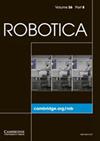End-to-end deep learning-based framework for path planning and collision checking: bin-picking application
IF 2.7
4区 计算机科学
Q3 ROBOTICS
引用次数: 0
Abstract
Real-time and efficient path planning is critical for all robotic systems. In particular, it is of greater importance for industrial robots since the overall planning and execution time directly impact the cycle time and automation economics in production lines. While the problem may not be complex in static environments, classical approaches are inefficient in high-dimensional environments in terms of planning time and optimality. Collision checking poses another challenge in obtaining a real-time solution for path planning in complex environments. To address these issues, we propose an end-to-end learning-based framework viz., Path Planning and Collision checking Network (PPCNet). The PPCNet generates the path by computing waypoints sequentially using two networks: the first network generates a waypoint, and the second one determines whether the waypoint is on a collision-free segment of the path. The end-to-end training process is based on imitation learning that uses data aggregation from the experience of an expert planner to train the two networks, simultaneously. We utilize two approaches for training a network that efficiently approximates the exact geometrical collision checking function. Finally, the PPCNet is evaluated in two different simulation environments and a practical implementation on a robotic arm for a bin-picking application. Compared to the state-of-the-art path-planning methods, our results show significant improvement in performance by greatly reducing the planning time with comparable success rates and path lengths.基于端到端深度学习的路径规划和碰撞检查框架:垃圾箱拣选应用
实时高效的路径规划对所有机器人系统都至关重要。特别是对于工业机器人来说,由于整体规划和执行时间直接影响到生产线的周期时间和自动化经济性,因此它显得更为重要。虽然在静态环境中问题可能并不复杂,但在高维环境中,传统方法在规划时间和最优性方面效率低下。碰撞检查是在复杂环境中获得路径规划实时解决方案的另一个挑战。为了解决这些问题,我们提出了一个基于端到端学习的框架,即路径规划和碰撞检查网络(PPCNet)。PPCNet 通过使用两个网络依次计算航点来生成路径:第一个网络生成一个航点,第二个网络确定该航点是否在路径的无碰撞段上。端到端的训练过程基于模仿学习,利用专家规划师的经验数据汇总来同时训练两个网络。我们采用两种方法训练网络,以有效逼近精确的几何碰撞检查函数。最后,我们在两种不同的模拟环境中对 PPCNet 进行了评估,并在一个用于拣选垃圾的机械臂上进行了实际应用。与最先进的路径规划方法相比,我们的结果表明,在成功率和路径长度相当的情况下,规划时间大大缩短,性能显著提高。
本文章由计算机程序翻译,如有差异,请以英文原文为准。
求助全文
约1分钟内获得全文
求助全文
来源期刊

Robotica
工程技术-机器人学
CiteScore
4.50
自引率
22.20%
发文量
181
审稿时长
9.9 months
期刊介绍:
Robotica is a forum for the multidisciplinary subject of robotics and encourages developments, applications and research in this important field of automation and robotics with regard to industry, health, education and economic and social aspects of relevance. Coverage includes activities in hostile environments, applications in the service and manufacturing industries, biological robotics, dynamics and kinematics involved in robot design and uses, on-line robots, robot task planning, rehabilitation robotics, sensory perception, software in the widest sense, particularly in respect of programming languages and links with CAD/CAM systems, telerobotics and various other areas. In addition, interest is focused on various Artificial Intelligence topics of theoretical and practical interest.
 求助内容:
求助内容: 应助结果提醒方式:
应助结果提醒方式:


